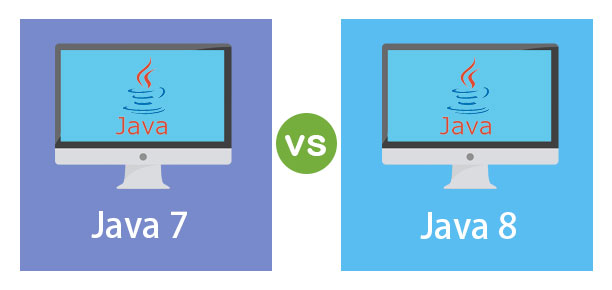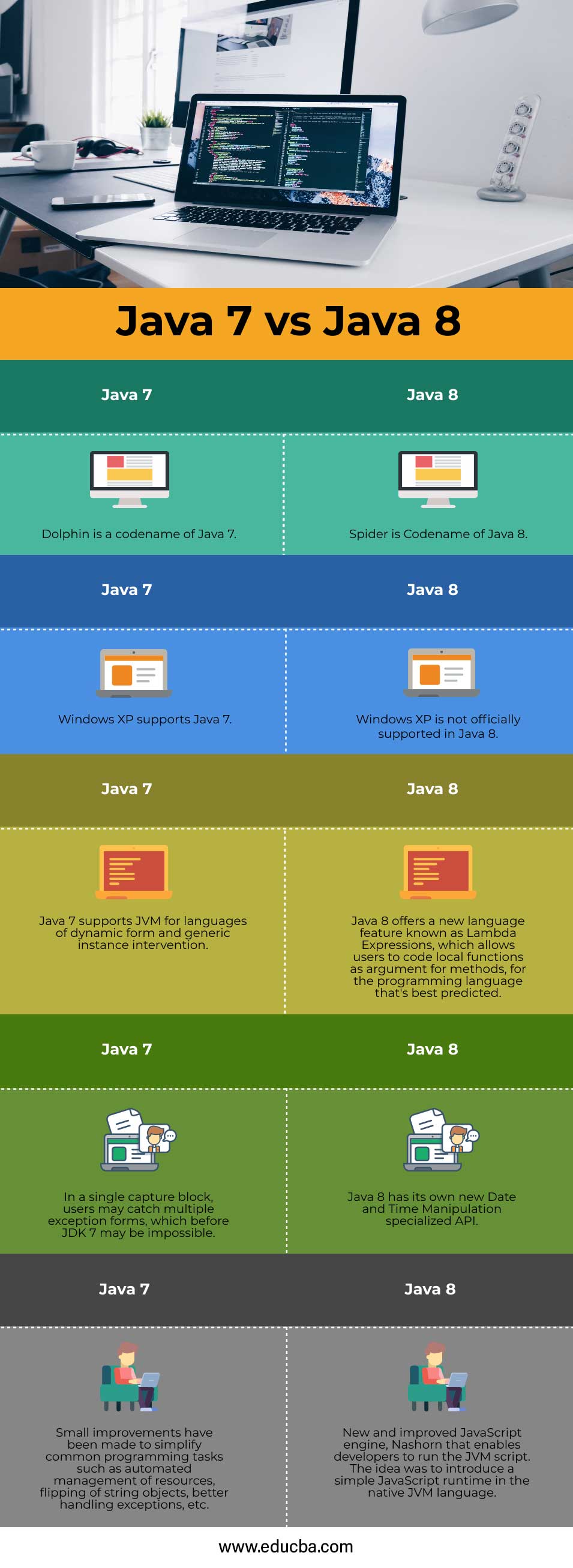Updated July 1, 2023
Difference Between Java 7 vs Java 8
What is Java 7: Since the merger of Sun Microsystems, Java 7 was the first main update in Java programming language under Oracle’s stewardship and ownership. On Jan 27, 2010, Oracle Corporation completed the final takeover. The American technology giant organized an event to celebrate the arrival of Java Standard Edition 7. The launch of Java SE 7 demonstrated the dedication of Oracle to speech and technology. Sun Microsystems company that developed the Java programming language, was a great achievement for the tech giants. Today, the wholly-owned subsidiary of Oracle Corporation, Sun Microsystems, operates the Sun server, MySQL, Solaris storage, and network hardware unit. Java 7 was a big success for Oracle in the 5 years following the acquisition and a major improvement for Java, almost taking the business to a completely new level. The new version includes many innovations that have raced through the programming field. The Java 7 release was solid, providing many major updates, including bug fixes and improved support for dynamic non-Java languages and generic class development interference support.
What is Java 8: Java SE 8 (Spider) is a groundbreaking software framework launch that brings many major upgrades and enhancements in Java programming, including the Java Script enhanced engine, new APIs for manipulating date and time, JVM enhanced and quicker, and more. Java SE 8 is a huge leap forward for the language of programming, which also brings the most awaited update of the technology giant – the lambda word. This new language feature is specifically included in the update Java 8 and is one of the most significant programming upgrades. This add-on eventually led to practical programming as a pioneer in the development platform. The Java Development Kit 8 was officially released by Oracle on Mar 18, 2014, marking a turning point for the global program. The company changed the programming model for functional programming to accommodate the new expressions of Lambda.
Head-to-Head Comparison Between Java 7 vs Java 8 (Infographics)
Below are the top 5 comparisons between Java 7 vs Java 8:
Key Differences Between Java 7 vs Java 8
Let us discuss some key differences between Java 7 vs Java 8:
- Since Sun Microsystems was acquired in 2010, Java SE 7 has been the first and only programming language update owned and managed by Oracle Corporation. Java 8 is the next largest Java 7 upgrade, with some important features and enhancements in the Java model.
- JVM supports dynamic languages, plus minor language improvements are one of the most notable features of Java’s 7. Java 8 is an important programming update that significantly upgrades Lambda Expressions to functional programming. Java 8 provides a JavaScript runtime that allows developers to embed JavaScript code within applications.
- Java 8 also has a new and improved Date / Time API, a JavaScript-enhanced core, and a new streaming API. Competitive batteries, safe and random generation, and much more. Java 7 improved the architecture for class initialization, improved controlled beans, support for multiple exceptions, etc.
- Java 7 has introduced String support so users can rewrite codes more easily and efficiently. He helps users write codes that are better to read. Java 8’s Lambda expressions allow you to code local functions as method arguments.
- Oracle stopped dispersing Java SE 7 security updates effective April 2015, but the current Java archive installations remain open. After September 2018, public updates of Java 8 will be discontinued. Java 8 provides Annotation on Java Types as well as Repeating annotations.
Comparison Table of Java 7 vs Java 8
The table below summarizes the comparisons between Java 7 vs Java 8:
| Java 7 |
Java 8 |
| Dolphin is a codename of Java 7. | Spider is the Codename of Java 8. |
| Windows XP supports Java 7. | Windows XP is not officially supported in Java 8. |
| Java 7 supports JVM for languages of dynamic form and generic instance intervention. | Java 8 offers a new language feature known as Lambda Expressions, which allows users to code local functions as an argument for methods for the programming language that’s best predicted. |
| In a single capture block, users may catch multiple exception forms, which before JDK 7 may be impossible. | Java 8 has its new Date and Time Manipulation specialized API. |
| Small improvements have been made to simplify common programming tasks such as automated management of resources, flipping of string objects, better-handling exceptions, etc. | A new and improved JavaScript engine, Nashorn, enables developers to run the JVM script. The idea was to introduce a simple JavaScript runtime in the native JVM language. |
Conclusion
In this article, we have seen what is Java 7 and Java 8, the major differences between Java 7 and Java 8, along with a comparison table.
Recommended Articles
We hope that this EDUCBA information on “Java 7 vs Java 8” was beneficial to you. You can view EDUCBA’s recommended articles for more information.




